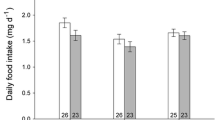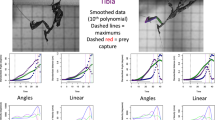Summary
Predation by naticid gastropods shows evidence of adaptation to maximize the rate of energy intake. The predation rate of Polinices duplicatus feeding on artificially altered, thin-shelled Mercenaria mercenaria was faster than the predation rate on normal Mercenaria. The rate of energy intake was limited by handling time. The time saved by predation on thin-shelled prey was used to forage. Thus time was shown to be valuable to P. duplicatus, and cost-benefit functions using time and energy as currencies are appropriate for estimating dietary efficiency and predicting prey choice.
Despite the clear superiority of thin-shelled prey, P. duplicatus did not learn to prefer this novel prey type, suggesting that predator choices are sterotyped, reflecting optima selected over evolutionary time.
Similar content being viewed by others
References
Charnov EL (1976) Optimal foraging: attack strategy of a mantid. Am Nat 110:141–151
Cochran WG, Cox GM (1957) Experimental designs. 2nd edition. 611 pp. Wiley, New York
De Angelis D, Kitchell JA, Post WM, Travis CC (1984) A model of naticid gastropod predator-prey coevolution. Lecture Notes in Biomath (in press)
Edwards DC (1974) Preferred prey of Polinices duplicatus in Cape Cod inlets. Bull Am Malacol Union 40:17–20
Edwards DC, Huebner JD (1977) Feeding and growth rates of Polinices duplicatus preying on Mya arenaria at Barnstable Harbor, Massachusetts. Ecology 58:1218–1236
Goss-Custard JD (1977) Optimal foraging and the size selection of worms by redshank Tringa totanus. Anim Behav 25:10–29
Grizzle JE (1965) The two period change-over design and its use in clinical trials. Biometrics 21:467–480
Hughes RN (1979) Optimal diets under the energy maximization premise: the effects of recognition time and learning. Am Nat 13:209–211
Kitchell JA (1982) Coevolution in a predator-prey system. North Amer Paleontol Conv III 2:301–305
Kitchell JA, Boggs CH, Kitchell JF, Rice JA (1981) Prey selection by naticid gastropods: experimental tests and application to the fossil record. Paleobiology 7:533–552
Krebs JR (1978) Optimal foraging: decision rules for predators. In: JR Krebs, NB Davies (eds), Behavioral ecology. Sinauer Assoc, Sunderland Massachusetts pp 23–63
Krebs JR, Ericksen JT, Webber MI, Charnov EL (1977) Optimal prey selection in the Great Tit (Parus major) Animal Behavior 25:30–38
Lehmann EL (1975) Nonparametrics: statistical methods based on ranks 457 pp. McGraw-Hill, New York
Menge JL (1974) Prey selection and foraging period of the predaceous rocky intertidal nail, Acanthina punctulata. Oecologia (Berlin) 17:293–316
Murdoch WW (1969) Switching in general predators: experiments on predator specificity and stability of prey populations. Ecol Monogr 39:335–354
Palmer AR (1981) Predation and parallel evolution: recurrent parietal plate reduction in balanomorph barnacles. Paleobiology 8:31–44
Pyke GH, Pulliam HR, Charnov EL (1977) Optimal foraging: a selective review of theroy and tests. Q Rev Biol 52:137–154
Schoener TW (1969) Optimal size and specialization in constant and fluctuating environments: an energy-time approach. Brookhaven Symp Biol 32:103–114
Schoener TW (1971) Theory of feeding strategies. Annu Rev Ecol Syst 2:369–404
Schoener TW (1983) Simple models of optimal feeding-territory size: a reconciliation. Am Nat 121:608–629
Werner EE, Hall DJ (1974) Optimal foraging and the size selection of prey by the bluegill sunfish (Lepomis macrochirus). Ecology 55:1042–1052
Wiltse WI (1978) Effects of predation by Polinices duplicatus on community structure. PhD thesis, University of Massachusetts
Author information
Authors and Affiliations
Rights and permissions
About this article
Cite this article
Boggs, C.H., Rice, J.A., Kitchell, J.A. et al. Predation at a snail's pace: what's time to a gastropod?. Oecologia 62, 13–17 (1984). https://doi.org/10.1007/BF00377366
Received:
Issue Date:
DOI: https://doi.org/10.1007/BF00377366




